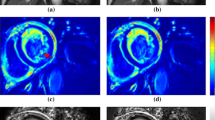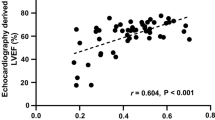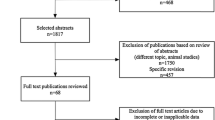Abstract
Objective
To evaluate the accuracy, reliability and time saving potential of a novel cardiac CT (CCT)-based, automated software for the assessment of segmental left ventricular function compared to visual and manual quantitative assessment of CCT and cardiac magnetic resonance (CMR).
Methods
Forty-seven patients with suspected or known coronary artery disease (CAD) were enrolled in the study. Wall thickening was calculated. Segmental LV wall motion was automatically calculated and shown as a colour-coded polar map. Processing time for each method was recorded.
Results
Mean wall thickness in both systolic and diastolic phases on polar map, CCT, and CMR was 9.2 ± 0.1 mm and 14.9 ± 0.2 mm, 8.9 ± 0.1 mm and 14.5 ± 0.1 mm, 8.3 ± 0.1 mm and 13.6 ± 0.1 mm, respectively. Mean wall thickening was 68.4 ± 1.5 %, 64.8 ± 1.4 % and 67.1 ± 1.4 %, respectively. Agreement for the assessment of LV wall motion between CCT, CMR and polar maps was good. Bland–Altman plots and ICC indicated good agreement between CCT, CMR and automated polar maps of the diastolic and systolic segmental wall thickness and thickening. The processing time using polar map was significantly decreased compared with CCT and CMR.
Conclusion
Automated evaluation of segmental LV function with polar maps provides similar measurements to manual CCT and CMR evaluation, albeit with substantially reduced analysis time.
Key Points
• Cardiac computed tomography (CCT) can accurately assess segmental left ventricular wall function.
• A novel automated software permits accurate and fast evaluation of wall function.
• The software may improve the clinical implementation of segmental functional analysis.


Similar content being viewed by others
Abbreviations
- CAD:
-
Coronary artery disease
- CCT:
-
Cardiac computed tomography
- CMR:
-
Cardiac magnetic resonance
- CABG:
-
Coronary artery bypasses graft
- ED:
-
End-diastolic
- ES:
-
End-systolic
- GFR:
-
Glomerular filtration rate
- ICC:
-
Interclass-correlation coefficient
- LVEF:
-
Left ventricular ejection fraction
- SSFP:
-
Steady-state free precession
References
Seneviratne SK, Truong QA, Bamberg F, Rogers IS, Shapiro MD, Schlett CL et al (2010) Incremental diagnostic value of regional left ventricular function over coronary assessment by cardiac computed tomography for the detection of acute coronary syndrome in patients with acute chest pain: from the ROMICAT trial. Circ Cardiovasc Imaging 3(4):375–383
Malm S, Frigstad S, Sagberg E, Larsson H, Skjaerpe T (2004) Accurate and reproducible measurement of left ventricular volume and ejection fraction by contrast echocardiography: a comparison with magnetic resonance imaging. J Am Coll Cardiol 44(5):1030–1035
Bellenger NG, Burgess MI, Ray SG, Lahiri A, Coats AJ, Cleland JG et al (2000) Comparison of left ventricular ejection fraction and volumes in heart failure by echocardiography, radionuclide ventriculography and cardiovascular magnetic resonance; are they interchangeable? Eur Heart J 21(16):1387–1396
Petersen JW, Forder JR, Thomas JD, Moye LA, Lawson M, Loghin C et al (2011) Quantification of myocardial segmental function in acute and chronic ischemic heart disease and implications for cardiovascular cell therapy trials: a review from the NHLBI-Cardiovascular Cell Therapy Research Network. JACC Cardiovasc Imaging 4(6):671–679
Arraiza M, Azcarate PM, De Cecco CN, Viteri G, Simon-Yarza I, Hernandez-Estefania R et al (2012) Assessment of left ventricular parameters in orthotopic heart transplant recipients using dual-source CT and contrast-enhanced echocardiography: comparison with MRI. Eur J Radiol 81(11):3282–3288
Bastarrika G, Arraiza M, De Cecco CN, Broncano J, Mastrobuoni S, Ubilla M et al (2009) Dual-source CT in heart transplant recipients: quantification of global left ventricular function and mass. J Thorac Imaging 24(2):103–109
Bastarrika G, Arraiza M, De Cecco CN, Mastrobuoni S, Ubilla M, Rabago G (2008) Quantification of left ventricular function and mass in heart transplant recipients using dual-source CT and MRI: initial clinical experience. Eur Radiol 18(9):1784–1790
Cury RC, Nieman K, Shapiro MD, Butler J, Nomura CH, Ferencik M et al (2008) Comprehensive assessment of myocardial perfusion defects, regional wall motion, and left ventricular function by using 64-section multidetector CT. Radiology 248(2):466–475
Ko SM, Kim YJ, Park JH, Choi NM (2010) Assessment of left ventricular ejection fraction and regional wall motion with 64-slice multidetector CT: a comparison with two-dimensional transthoracic echocardiography. Br J Radiol 83(985):28–34
Tsai IC, Huang YL, Liao WC, Kao KH, Chen MC (2009) Left ventricular myocardial volumes measured during arterial and delayed phases of multidetector row computed tomography: a study on intra- and interobserver variability. Int J Cardiovasc Imaging 25(Suppl 1):55–63
Asferg C, Usinger L, Kristensen TS, Abdulla J (2012) Accuracy of multi-slice computed tomography for measurement of left ventricular ejection fraction compared with cardiac magnetic resonance imaging and two-dimensional transthoracic echocardiography: a systematic review and meta-analysis. Eur J Radiol 81(5):e757–e762
Belge B, Coche E, Pasquet A, Vanoverschelde JL, Gerber BL (2006) Accurate estimation of global and regional cardiac function by retrospectively gated multidetector row computed tomography: comparison with cine magnetic resonance imaging. Eur Radiol 16(7):1424–1433
Aviram G, Sirota-Cohen C, Steinvil A, Keren G, Banai S, Sosna J et al (2012) Automated volumetric analysis of four cardiac chambers in pulmonary embolism: a novel technology for fast risk stratification. Thromb Haemost 108(2):384–393
Raman SV, Shah M, McCarthy B, Garcia A, Ferketich AK (2006) Multi-detector row cardiac computed tomography accurately quantifies right and left ventricular size and function compared with cardiac magnetic resonance. Am Heart J 151(3):736–744
Cerqueira MD, Weissman NJ, Dilsizian V, Jacobs AK, Kaul S, Laskey WK et al (2002) Standardized myocardial segmentation and nomenclature for tomographic imaging of the heart. A statement for healthcare professionals from the Cardiac Imaging Committee of the Council on Clinical Cardiology of the American Heart Association. Circulation 105(4):539–542
Fischbach R, Juergens KU, Ozgun M, Maintz D, Grude M, Seifarth H et al (2007) Assessment of regional left ventricular function with multidetector-row computed tomography versus magnetic resonance imaging. Eur Radiol 17(4):1009–1017
Bruners P, Mahnken AH, Knackstedt C, Luhmann N, Spuntrup E, Das M et al (2007) Assessment of global left and right ventricular function using dual-source computed tomography (DSCT) in comparison to MRI: an experimental study in a porcine model. Investig Radiol 42(11):756–764
Acknowledgments
The scientific guarantor of this publication is U. Joseph Schoepf. The authors of this manuscript declare relationships with the following companies: UJS is a consultant for and receives research support from Bayer, Bracco, GE Medrad, and Siemens. The other authors declare that they have no financial disclosures. The authors state that this work has not received any funding. No complex statistical methods were necessary for this paper. Institutional Review Board approval was obtained. Written informed consent was obtained from all subjects (patients) in this study. No study subjects or cohorts have been previously reported. Methodology: retrospective, diagnostic study, performed at one institution.
Author information
Authors and Affiliations
Corresponding author
Rights and permissions
About this article
Cite this article
Wang, R., Meinel, F.G., Schoepf, U.J. et al. Performance of Automated Software in the Assessment of Segmental Left Ventricular Function in Cardiac CT: Comparison with Cardiac Magnetic Resonance. Eur Radiol 25, 3560–3566 (2015). https://doi.org/10.1007/s00330-015-3767-3
Received:
Revised:
Accepted:
Published:
Issue Date:
DOI: https://doi.org/10.1007/s00330-015-3767-3




